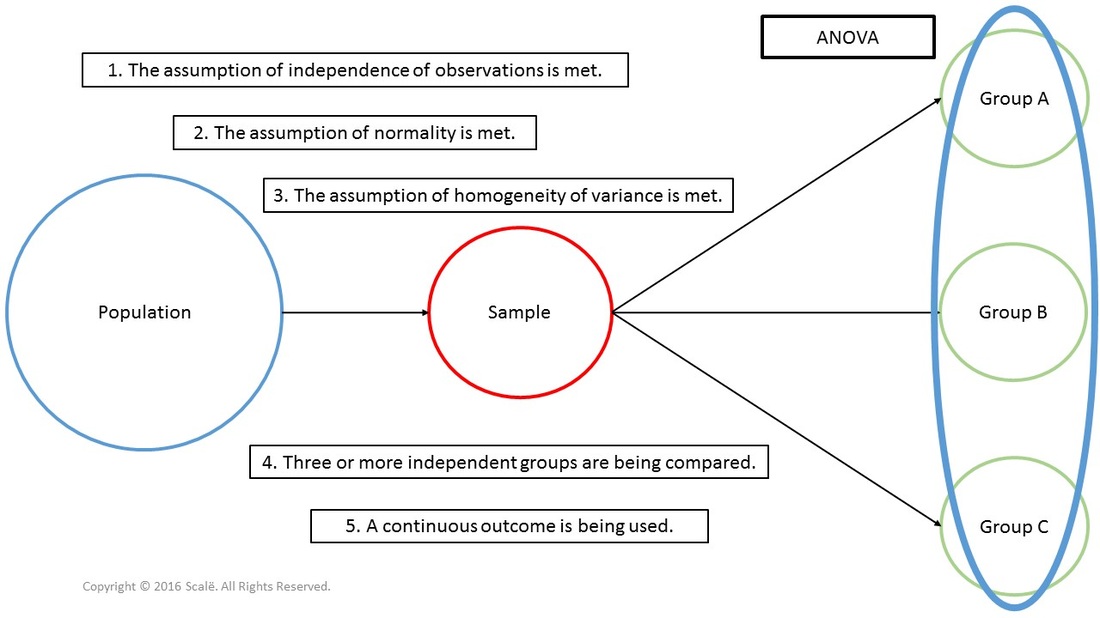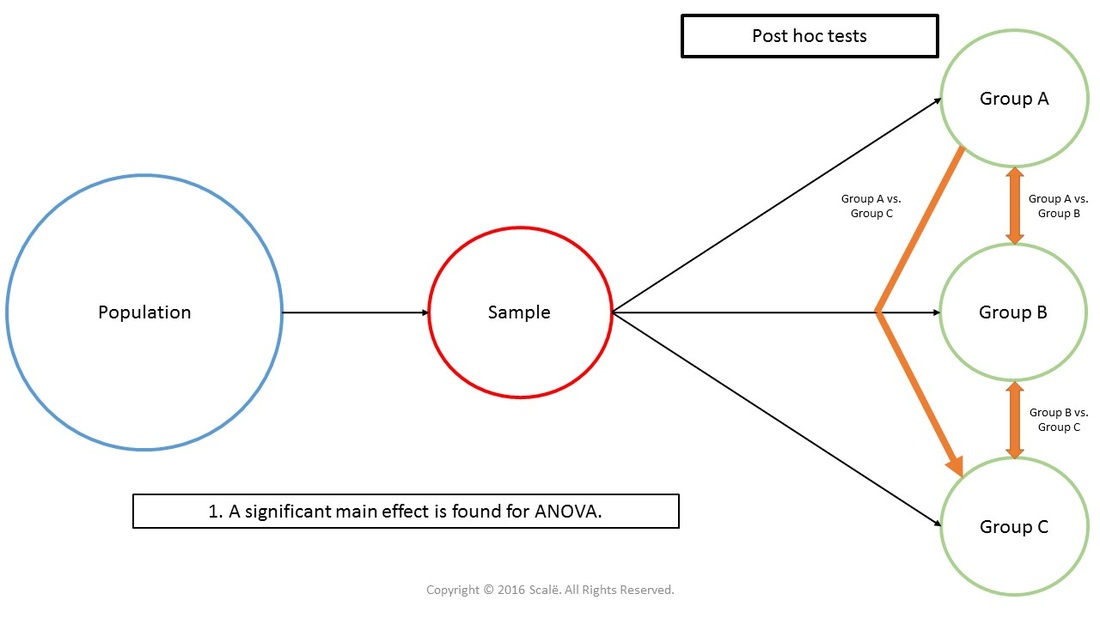ANOVA
Compare three or more independent groups on a continuous outcome after meeting statistical assumptions
ANOVA (analysis of variance) is used to compare three or more independent groups on a continuous outcome. The assumption of normality and the assumption of homogeneity of variance must be met before running an ANOVA. The p-value for an ANOVA is always interpreted within the context of the means and standard deviations of the multiple groups.
This figure depicts the use of an ANOVA. The statistical assumptions of independence of observations, normality, and homogeneity of variance have been met. There are three or more independent groups being compared in a between-subjects fashion and a continuous outcome is being used.
The steps for conducting an ANOVA in SPSS
1. Click Analyze.
2. Drag the cursor over the Compare Means drop-down menu.
3. Click on One-way ANOVA.
4. Click on the continuous outcome variable to highlight it.
5. Click on the arrow to move the outcome variable into the Dependent List: box.
6. Click on the "grouping" variable to highlight it.
7. Click on the arrow to move the "grouping" variable into the Factor: box.
8. Click on the Options button.
9. In the Statistics table, click the Descriptive box.
10. In the Statistics table, click the Homogeneity of variance test box.
11. Click Continue.
12. Click OK.
2. Drag the cursor over the Compare Means drop-down menu.
3. Click on One-way ANOVA.
4. Click on the continuous outcome variable to highlight it.
5. Click on the arrow to move the outcome variable into the Dependent List: box.
6. Click on the "grouping" variable to highlight it.
7. Click on the arrow to move the "grouping" variable into the Factor: box.
8. Click on the Options button.
9. In the Statistics table, click the Descriptive box.
10. In the Statistics table, click the Homogeneity of variance test box.
11. Click Continue.
12. Click OK.
The steps for interpreting the SPSS output for an ANOVA
1. In the Descriptives table, there are several important pieces of information about each independent group in the "grouping" variable including the size of each group (N) and their respective means (Mean) and standard deviations (Std. Deviation). Disregard the other values for practical purposes.
2. Researchers have already assessed the assumption of homogeneity of variance.
3. In the ANOVA table, look under the Sig. column.
If the p-value is LESS THAN .05, then researchers have evidence of a statistically significant main effect between the independent groups.
If the p-value is MORE THAN .05, then researchers have evidence that there is not a statistically significant main effect between the independent groups.
2. Researchers have already assessed the assumption of homogeneity of variance.
3. In the ANOVA table, look under the Sig. column.
If the p-value is LESS THAN .05, then researchers have evidence of a statistically significant main effect between the independent groups.
If the p-value is MORE THAN .05, then researchers have evidence that there is not a statistically significant main effect between the independent groups.
If a significant main effect is found, then post hoc comparisons have to be conducted to see where the actual differences exist among the independent groups.
This figure depicts post hoc tests being run after a significant main effect is found for ANOVA.
The steps for conducting post hoc tests for an ANOVA in SPSS
1. Click Analyze.
2. Drag the cursor over the Compare Means drop-down menu.
3. Click on One-way ANOVA.
4. Click on the continuous outcome variable to highlight it.
5. Click on the arrow to move the outcome variable into the Dependent List: box.
6. Click on the "grouping" variable to highlight it.
7. Click on the arrow to move the "grouping" variable into the Factor: box.
8. Click on the Options button.
9. In the Statistics table, click the Descriptive box.
10. In the Statistics table, click the Homogeneity of variance test box.
11. Click Continue.
12. Click on the Post Hoc button.
13. Click on the Bonferroni, Tukey, and Scheffe boxes to select them.
14. Click Continue.
15. Click OK.
2. Drag the cursor over the Compare Means drop-down menu.
3. Click on One-way ANOVA.
4. Click on the continuous outcome variable to highlight it.
5. Click on the arrow to move the outcome variable into the Dependent List: box.
6. Click on the "grouping" variable to highlight it.
7. Click on the arrow to move the "grouping" variable into the Factor: box.
8. Click on the Options button.
9. In the Statistics table, click the Descriptive box.
10. In the Statistics table, click the Homogeneity of variance test box.
11. Click Continue.
12. Click on the Post Hoc button.
13. Click on the Bonferroni, Tukey, and Scheffe boxes to select them.
14. Click Continue.
15. Click OK.
The steps for interpreting the SPSS output for post hoc tests with ANOVA
In the Multiple Comparisons table, look under the Sig. column.
If the p-value is LESS THAN .05, then there is a statistically significant difference between the two independent groups identified in the (I) Group and (J) Group columns.
If the p-value is MORE THAN .05, then there is not a statistically significant difference between the two independent groups identified in the (I) Group and (J) Group columns.
If the p-value is LESS THAN .05, then there is a statistically significant difference between the two independent groups identified in the (I) Group and (J) Group columns.
If the p-value is MORE THAN .05, then there is not a statistically significant difference between the two independent groups identified in the (I) Group and (J) Group columns.
In order to properly interpret the p-values, it must be done within the context of the means and standard deviations. For example, researchers would say:
"There was a significant main effect for the outcome, p < .05. Post hoc comparisons were conducted. There were significant differences between Group 1 (mean and standard deviation), Group 2 (mean and standard deviation), and Group 3 (mean and standard deviation), p = .01."
It is HIGHLY IMPORTANT to interpret the p-values within the context of the means and standard deviations that are presented in the Descriptives table.
"There was a significant main effect for the outcome, p < .05. Post hoc comparisons were conducted. There were significant differences between Group 1 (mean and standard deviation), Group 2 (mean and standard deviation), and Group 3 (mean and standard deviation), p = .01."
It is HIGHLY IMPORTANT to interpret the p-values within the context of the means and standard deviations that are presented in the Descriptives table.
Click on the Download Database and Download Data Dictionary buttons for a configured database and data dictionary for ANOVA. Click on the Adjusting for Multiple Comparisons button to learn more about Bonferroni, Tukey's HSD, and Scheffe's test. Click on the Validation of Statistical Findings button to learn more about bootstrap, split-group, and jack-knife validation methods.
Statistician For Hire
DO YOU NEED TO HIRE A STATISTICIAN?
Eric Heidel, Ph.D. will provide statistical consulting for your research study at $100/hour. Secure checkout is available with PayPal, Stripe, Venmo, and Zelle.
- Statistical Analysis
- Sample Size Calculations
- Diagnostic Testing and Epidemiological Calculations
- Psychometrics


